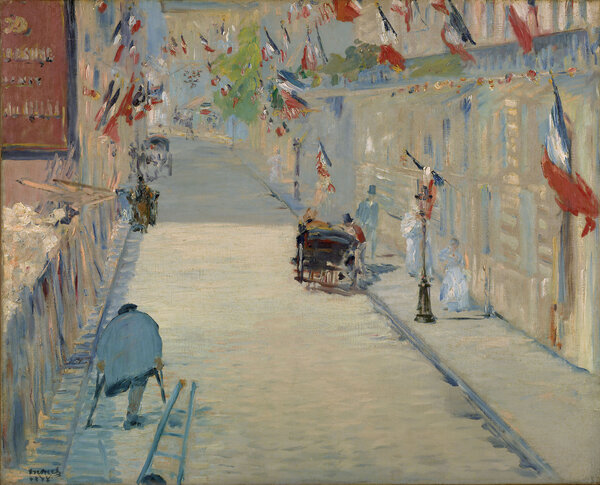After a violent upheaval, impressionists chose beauty
Visitors to a new exhibition at the National Gallery of Art in Washington, “Paris 1874: The Impressionist Moment,” are greeted early on by war. The Franco-Prussian War – and the devastating insurrection in its wake – to be exact.
To Sebastian Smee, art critic for The Washington Post, that is a good place to start. Any consideration of the origin of the beloved art movement, he noted in a recent column, needs to include an understanding of the depravations and loss French society endured before it.
In his latest book, “Paris in Ruins: Love, War, and the Birth of Impressionism,” he convincingly argues that the Franco-Prussian War, which began in July 1870 and lasted six months, was more than just an interruption in the timeline of the burgeoning movement. Rather, he contends, more than any other development, the war decisively shaped the lives and careers of impressionism’s major players.

The central artists had very diverse experiences during this tumultuous time. Édouard Manet, Edgar Degas, and Berthe Morisot remained in Paris and were actively involved in military and political matters. Pierre-Auguste Renoir served in a military regiment outside the city. Claude Monet and Camille Pissarro fled to England, where the art establishment was unwelcoming. Paul Cézanne retreated to the south of France to avoid military service. Frédéric Bazille was killed on the front lines.
Smee organizes the book by focusing on the experiences of Manet, Degas, and Morisot, especially during the war and the rise of the Commune – a group dominated by anarchists and revolutionaries elected to govern Paris after Napoléon was defeated by Germany in the war.
Each of the artists wrote frequent, detailed letters to family and friends, and this provides a good picture of the hardship and devastation they witnessed. The author pays particular attention to the relationship between Manet and Morisot. They were exceptionally close – Smee uses the word “love” to characterize their relationship – but does not conclude that they were lovers.
For Morisot the year was especially traumatic, and she features prominently in Smee’s account. Morisot was unmarried and in frail health. The already married Manet was unavailable. Her much-loved older sister had recently married, moved to Normandy, stopped painting, and started a family. Morisot’s future looked sad and lonely. It was during this year, Smee asserts, that she made a commitment to become a professional painter, a remarkable decision for someone of her gender and class in 19th-century France.
When she made the decision, she found herself increasingly drawn to the rococo painters of the 18th century and their “scenes of intimacy, youth and femininity. They embraced happiness and grace, in ways that appealed to Morisot.” The changes to her art came slowly at first. “She worked in watercolors, trying to to find her way into a new language of lightness and evanescence – a language based in close observation, devoid of rhetoric or hysteria.”
In May 1871, the French army stormed Paris, destroyed the Commune, and killed thousands of communards – many by summary execution. But the end of the Commune did not mark the end of the turmoil. France suffered political convulsions for the rest of the decade.
Art, too, was a battleground. Smee writes that “Public calls to renovate French art – to shun radical experiment, to recommit to patriotic subjects, to find again value in tradition – grew even louder.” Art, wrote one critic, “must produce virile and grand works, worthy of the task in front of us.”
But the events of what author Victor Hugo called “The Terrible Year” fundamentally altered the worldview of the avant-
garde artists. For them, there was no going back. When the young artists gradually reconvened in Paris, they began to paint “what they yearned for: a secular, open, and democratic society where nature, commerce, and industry were in a provisional, constantly evolving struggle for harmony, in configurations that were as changeable and unsettled as the weather. ... [Their] work was rooted in the here-and-now rather than in exhausted mythologies, religious parables or legends of the ancients.”
The conservative art establishment’s “program of national rejuvenation,” which would have required them to paint moralistic, uplifting subjects with obvious displays of technical skill and finish, was completely at odds with the younger artists’ “loose, unfinished-looking brushstrokes that captured colored light and sensations of transience.”
Between 1874 and 1886, the impressionists staged eight exhibitions that presented their vision to a skeptical public. The path was rocky. The first, in 1874 – offered 150 years before the current well-regarded exhibit at the National Gallery – was widely panned. Acceptance came slowly. The artists found themselves in bitter disagreement over the years, and some of the most important members of the group – including Manet, Morisot, and Gustave Caillebotte – died long before the triumph of impressionism was clear. But they had inspired other young artists both inside and outside France to follow their own vision and, by doing so, destroyed the power of the art establishment to put in place any sort of official or state-approved art. They also created some of the most loved and recognized artwork in history.
Smee examines the political history of the era in detail and devotes considerable attention to the military aspects of the Franco-Prussian War. In doing so, he conveys a clear and compelling idea of the time that the radical young artists lived through and how it altered their vision and inspired them to move forward. Smee blends political and military history and biography into a seamless narrative that will fundamentally change the way that we think about the emergence of impressionism. For art history lovers, this is required reading.









